放线菌属的分类及描述
- 格式:docx
- 大小:2.85 MB
- 文档页数:12
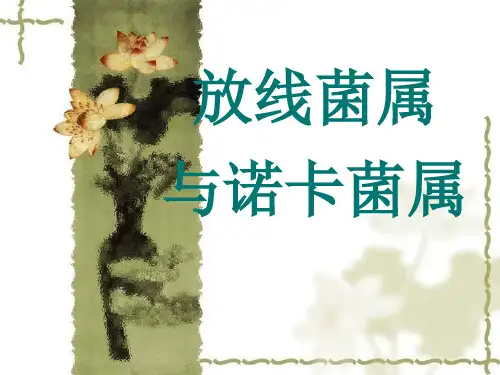
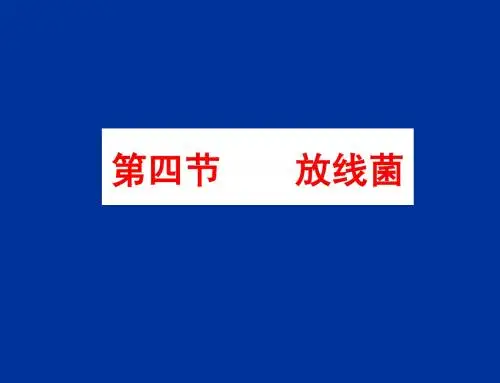
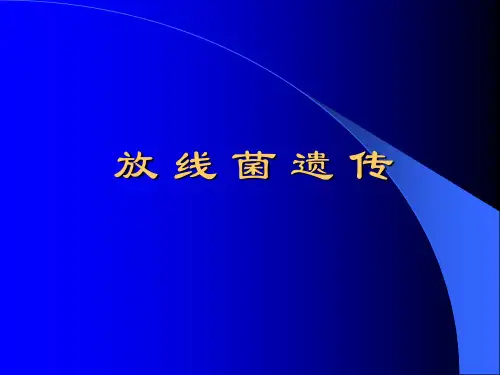
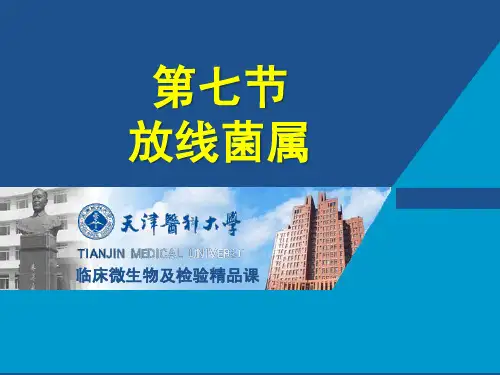
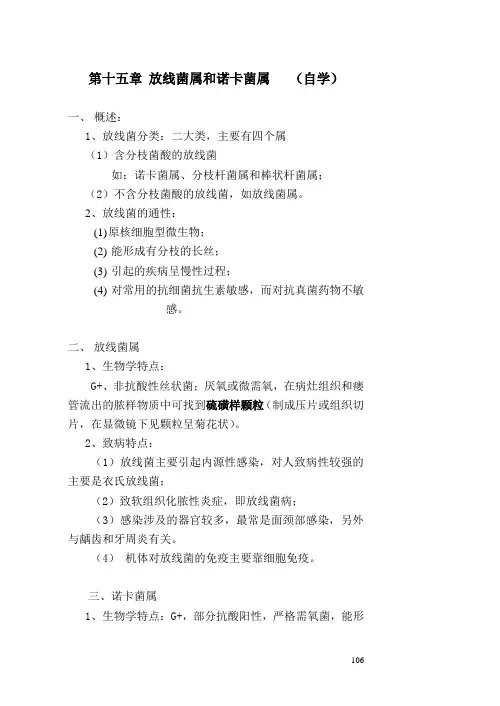
第十五章放线菌属和诺卡菌属(自学)
一、概述:
1、放线菌分类:二大类,主要有四个属
(1)含分枝菌酸的放线菌
如:诺卡菌属、分枝杆菌属和棒状杆菌属;
(2)不含分枝菌酸的放线菌,如放线菌属。
2、放线菌的通性:
(1)原核细胞型微生物;
(2)能形成有分枝的长丝;
(3)引起的疾病呈慢性过程;
(4)对常用的抗细菌抗生素敏感,而对抗真菌药物不敏
感。
二、放线菌属
1、生物学特点:
G+、非抗酸性丝状菌;厌氧或微需氧,在病灶组织和瘘管流出的脓样物质中可找到硫磺样颗粒(制成压片或组织切片,在显微镜下见颗粒呈菊花状)。
2、致病特点:
(1)放线菌主要引起内源性感染,对人致病性较强的主要是衣氏放线菌;
(2)致软组织化脓性炎症,即放线菌病;
(3)感染涉及的器官较多,最常是面颈部感染,另外与龋齿和牙周炎有关。
(4)机体对放线菌的免疫主要靠细胞免疫。
三、诺卡菌属
1、生物学特点:G+,部分抗酸阳性,严格需氧菌,能形
106
成气生菌丝。
2、致病特点:
呈外源性感染,对人致病的主要有3种:星形、豚鼠和巴西诺卡菌,我国最常见的为星形诺卡菌;
通过吸入或创伤感染,病变以化脓和坏死为特征。
107。
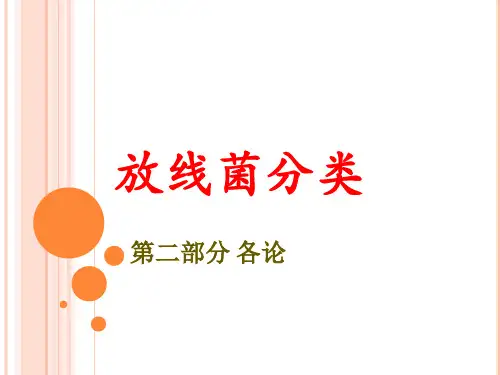
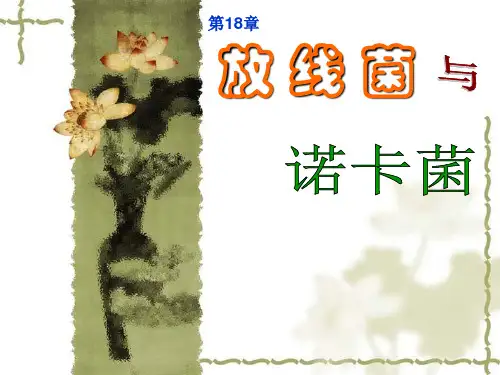


什么是放线菌引言放线菌(Actinobacteria)是一类广泛存在于自然环境中的细菌,也是一类非常重要的微生物资源。
它们具有丰富的代谢能力和生物活性产物,对于农业、药物开发、环境保护等领域具有重要的应用价值。
放线菌的研究和应用已经成为微生物学和生物技术领域的热点之一。
本文将从分类特征、生物特性、应用领域等方面对放线菌进行详细介绍。
一、分类特征1. 形态特征放线菌是革兰氏阳性细菌,其细胞多为直杆状,长为0.2-2.0μm,直径为0.5-1.0μm。
有的放线菌细胞会形成分枝或丝状结构,使得其菌落呈现放射状生长。
2. 细胞壁特征放线菌的细胞壁主要由多肽聚糖组成,其中N-乙酰葡萄醣胺和N-乙酰半乳葡萄糖胺是其特征性成分。
这些特殊的细胞壁结构使得放线菌对抗生物膜、抗药物和耐酸碱有一定的能力。
3. 分类系统放线菌属于细菌界放线菌纲(Actinobacteria),目前已知的放线菌约有50个属。
根据形态特征、生理和生态习性等分类指标,放线菌可以进一步分为不同的科、属和种。
二、生物特性1. 生长环境放线菌广泛存在于土壤、水体和植物表面等自然环境中。
它们对土壤质地、pH值、湿度和养分含量等因素有一定的适应性,因此在地球生态系统中分布十分广泛。
2. 代谢能力放线菌具有丰富的代谢能力,可以利用多种有机物和无机物作为碳源、氮源和能源。
许多放线菌具有优良的降解能力,能够降解有机污染物和农药,对环境保护具有重要的意义。
3. 生物活性产物放线菌是许多重要天然产物的产生者,其中包括抗生素、抗肿瘤活性物质、抗氧化物质等。
这些生物活性产物对细菌、真菌和肿瘤细胞等具有显著的抑制或杀灭作用,对人类的健康和医疗具有重要意义。
三、应用领域1. 农业应用放线菌具有优良的土壤分解和降解能力,可以降解农药残留、处理农业废弃物等。
此外,放线菌还能够产生一些具有生物肥料作用的物质,可以促进植物的生长和发育。
2. 药物开发放线菌是抗生素的重要来源之一,许多著名的抗生素如链霉素、土霉素等都是由放线菌产生的。

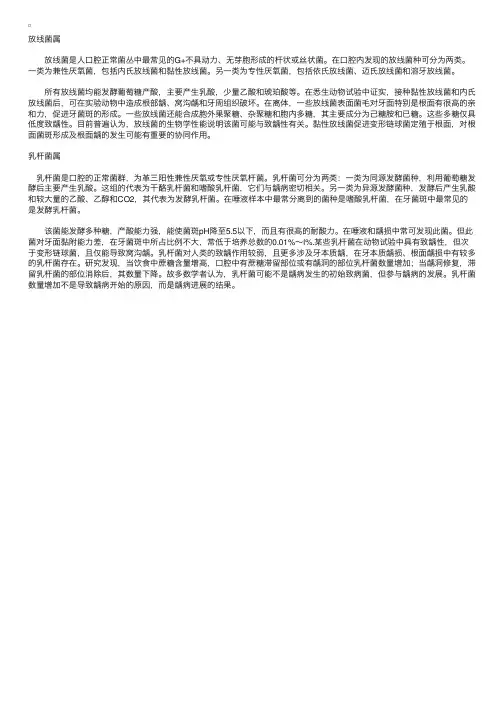
放线菌属 放线菌是⼈⼝腔正常菌丛中最常见的G+不具动⼒、⽆芽胞形成的杆状或丝状菌。
在⼝腔内发现的放线菌种可分为两类。
⼀类为兼性厌氧菌,包括内⽒放线菌和黏性放线菌。
另⼀类为专性厌氧菌,包括依⽒放线菌、迈⽒放线菌和溶⽛放线菌。
所有放线菌均能发酵葡萄糖产酸,主要产⽣乳酸,少量⼄酸和琥珀酸等。
在悉⽣动物试验中证实,接种黏性放线菌和内⽒放线菌后,可在实验动物中造成根部龋、窝沟龋和⽛周组织破坏。
在离体,⼀些放线菌表⾯菌⽑对⽛⾯特别是根⾯有很⾼的亲和⼒,促进⽛菌斑的形成。
⼀些放线菌还能合成胞外果聚糖、杂聚糖和胞内多糖,其主要成分为⼰糖胺和已糖。
这些多糖仅具低度致龋性。
⽬前普遍认为,放线菌的⽣物学性能说明该菌可能与致龋性有关。
黏性放线菌促进变形链球菌定殖于根⾯,对根⾯菌斑形成及根⾯龋的发⽣可能有重要的协同作⽤。
乳杆菌属 乳杆菌是⼝腔的正常菌群,为⾰三阳性兼性厌氧或专性厌氧杆菌。
乳杆菌可分为两类:⼀类为同源发酵菌种,利⽤葡萄糖发酵后主要产⽣乳酸。
这组的代表为⼲酪乳杆菌和嗜酸乳杆菌,它们与龋病密切相关。
另⼀类为异源发酵菌种,发酵后产⽣乳酸和较⼤量的⼄酸、⼄醇和CO2,其代表为发酵乳杆菌。
在唾液样本中最常分离到的菌种是嗜酸乳杆菌,在⽛菌斑中最常见的是发酵乳杆菌。
该菌能发酵多种糖,产酸能⼒强,能使菌斑pH降⾄5.5以下,⽽且有很⾼的耐酸⼒。
在唾液和龋损中常可发现此菌。
但此菌对⽛⾯黏附能⼒差,在⽛菌斑中所占⽐例不⼤,常低于培养总数的0.01%~l%.某些乳杆菌在动物试验中具有致龋性,但次于变形链球菌,且仅能导致窝沟龋。
乳杆菌对⼈类的致龋作⽤较弱,且更多涉及⽛本质龋,在⽛本质龋损、根⾯龋损中有较多的乳杆菌存在。
研究发现,当饮⾷中蔗糖含量增⾼,⼝腔中有蔗糖滞留部位或有龋洞的部位乳杆菌数量增加;当龋洞修复,滞留乳杆菌的部位消除后,其数量下降。
故多数学者认为,乳杆菌可能不是龋病发⽣的初始致病菌,但参与龋病的发展。
乳杆菌数量增加不是导致龋病开始的原因,⽽是龋病进展的结果。
一、酸微菌亚纲(Acidimicrobidae)1 酸微菌目(Acidimicrobiales)酸微菌亚目(Acidimicrobineae)酸微菌科(Acidimicrobiaceae)酸微菌属(Acidimicrobium)典型种:氧化亚铁微酸菌(Acdimicrobium ferrooxidans)二、红色杆菌亚纲(Rubrobacteridae)1 红色杆菌目(Rubrobacterales)红色杆菌亚目(Rubrobacterineae)红色杆菌科(Rubrobacteraceae)红色杆菌属(Rubrobacter)2 土壤红杆菌目(Solirubrobacterales)土壤红杆菌科(Solirubrobacteraceae)扩展杆菌科(Patulibacteraceae)康奈斯氏杆菌科(Conexibacteraceae)康奈斯氏杆菌属(Conexibacter)3 嗜热油菌目(Thermoleophilales)嗜热油菌科(Thermoleophilacceae)嗜热油菌属(Thermoleophilum)三、红蝽杆菌亚纲(Coriobacteride)1 红蝽杆菌目(Coriobacteriales)红蝽杆菌科(Coriobacteriaceae)红蝽杆菌属(Coriobacterium)阿托波菌属(Atopobium)扣林氏菌属(Collinsella)神秘杆菌属(Cryptobacterium)反硝化杆菌属(Denitrobacterium)伊格尔兹氏菌属(Eggerthella)欧陆森氏菌属(Olsenella)斯莱克氏菌属(Slackia)非消化糖杆菌属(Asccharobacter)肠杆菌属(Enterorhabdus)戈登氏杆菌属(Gordonibacter)类伊格尔兹氏菌属(Paraeggerthella)四、腈基降解菌亚纲(Nitriliruptoride)1 腈基降解菌目(Nitriliruptorales)腈基降解菌科(Nitriliruptoraceae)腈基降解菌属(Nitriliruptor)2尤泽比氏菌目(Euzebyales)尤泽比氏菌科(Euzebyaceae)尤泽比氏菌属(Euzebya)五、放线菌亚纲(Actinobacteridae)1 放线菌目(Actinobacterales)放线菌亚目(Actinomycineae)放线菌科(Actinomycetaceae)放线菌属(Actinomyces)放线杆菌属(Actinobaculum)隐秘杆菌属(Arcanobacterium)动弯杆菌属(Mobiluncus)弯曲短杆菌属(Varibaculum)链霉菌亚目(Streptomycineae)链霉菌科(Sterptomycetaceae)链霉菌属(Streptomyces)北里孢菌属(Kitasatospora)链嗜酸菌属(Streptacidiphilus)链孢囊菌亚目(Streptosporangineae)链孢囊菌科(Streptosporangiaceae)链孢囊菌属(Streptosporangium)小双孢菌属(Microbispora)小四孢菌属(Microtetraspora)野野村氏菌属(Nonomuraea)游动单孢菌属(Planomonospora)游动双孢菌属(Planobispora)草孢菌属(Herbidospora)游动四孢菌属(Planotetraspora)高温多孢菌属(Thermopolyspora)果实包囊菌属(Acrocarpospora)球状包囊菌属(Sphaerisporangium)拟诺卡氏菌科(Nocardiopsaceae)拟诺卡氏菌属(Nocardiopsis)高温双岐菌属(Thermobifida)链单孢菌属(Streptomonospora)盐放线孢菌属(Haloactinospora)海洋放线孢菌属(Marinactinospora)高温单孢菌科(Thermomonosporaceae)高温单孢菌属(Thermomonospora)马杜拉放线菌属(Actinomadura)螺孢菌属(Spirillospora)珊瑚放线菌属(Actinocorallia)高温双孢菌属(Thermobispora)小单孢菌亚目(Micromonosporineae)小单孢菌科(Micromonosporaceae)小单孢菌属(Micromonospora)游动放线菌属(Actinoplanes)指孢囊菌属(Dactylosporangium)发仙菌属(Pilimelia)短链孢菌属(Catellatospora)短链游动菌属(Catenuloplanes)库奇游动菌属(Couchiolanes)螺旋游动菌属(Spirilliplanes)疣孢菌属(Verrucosispora)杆状孢囊菌属(Virgisporangium)长孢菌属(Longispora)阿森诺氏菌属(Asanoa)盐孢菌属(Salinispora)放线短链孢菌属(Actinocatenispora)多形态孢菌属(Polymorphospora)克拉西利尼科夫菌属(Krasilnikovia)卢得曼氏菌属(Luedemannella)假孢囊菌属(Pseudosporangium)游动孢囊菌属(Planosporangium)短链球孢囊菌(Catelliglobosispora)滨田氏菌属(Hamadaea)植物放线孢囊菌(Plantactinospora)皱纹单孢菌属(Rugosimonospora)植物栖居菌属(Phytohabitans)放线橘橙孢菌属(Actinaurispora)异短链球孢菌属(Allocatelliglobosispora)糖霉菌亚目(Glycomycineae)糖霉菌科(Glycomycetaceae)糖霉菌属(Glycomyces)斯塔堪布瑞德氏菌属(Stackebrandtia)盐糖霉菌属(Haloglycomyces)细链孢菌亚目(Catenulisporineae)细链孢菌科(Catenulisporaceae)细链孢菌属(Catenulispora)丛生放线菌科(Actinospicaceae)丛生放线菌属(Actinospica)放线多孢菌亚目(Actinopolysporineae)放线多孢菌科(Actinopolysporaceae)放线多孢菌属(Actinopolyspora)动球菌亚目(KIneococcineae)动球菌科(KIneococcaceae)动球菌属(KIneococcus)动孢菌属(Kineosporia)四折叠球菌属(Quadrisphaera)假诺卡氏亚目(Pseudonocardineae)假诺卡氏菌科(Pseudonocardiaceae)假诺卡氏菌属(Pseudonocardia)异壁放线菌菌属(Actinoalloteichus)拟无枝酸菌属(Amycolatopsis)克洛斯氏菌属(Crossiella)拟孢囊菌属(Kibdelosporangium)库兹涅尔氏菌属(Kutzneria)古德飞罗氏菌属(Goodfellowia)普劳斯氏菌属(Prauserella)糖单孢菌属(Saccharomonospora)糖多孢菌属(Saccharopolyspora)异壁链霉菌属(Streptoalloteichus)放线孢菌属(Actinomycetospora)异库兹涅尔氏菌属(Allokutzneria)南海海洋所菌属(Sciscionella)束丝放线菌科(Actinosynnemataceae)束丝放线菌属(Actinosynnema)列舍瓦列氏菌属(Lechevalier)伦兹氏菌属(Lentzea)糖丝菌属(Saccharothrix)动孢放线菌属(Actinokineospora)梅泽宾夫氏菌属(Umezawaea)弗兰克氏菌亚目(Frankineae)弗兰克氏菌科(Frankiaceae)弗兰克氏菌属(Frankia)热酸菌属(Acidothermus)隐孢囊菌科(Cryptosporangiaceae)隐孢囊菌属(Cryptosporangium)矿生菌属(Fodinicola)地嗜皮菌科(Geodermatophilaceae)地嗜皮菌(Geodermatophilus)芽生球菌属(Blastococcus)贫养杆菌属(Modestobacter)中村氏菌科(Nakamurellaceae)潮湿球菌属(Humicoccus)鱼孢菌科(Sporichthyaceae)鱼孢菌属(Sporichthya)棒杆菌亚目(Corynebacterineae)棒杆菌科(Corynebacteriaceae)棒杆菌属(Corynebacterium)苏黎世菌属(Turicella)迪茨氏菌科(Dietziaceae)分枝杆菌科(Mycobacteriaceae)分枝杆菌属(Mycobacterium)诺卡氏菌科(Nocardiaceae)诺卡氏菌属(Nocardia)戈登氏菌属(Gordonia)红球菌属(Rhodococcus)斯科曼氏菌属(Skermania)威廉姆斯氏菌属(Williamsia)米利斯氏菌属(Millisia)慢反应脂肪酸菌科(Segniliparaceae)慢反应脂肪酸菌属(Segniliparus)冢村氏菌科(Tsukamurellaceae)冢村氏菌属(Tsukamurella)微球菌亚目(Micrococcineae)微球菌科(Micrococcaceae)微球菌属(Micrococcus)螨共生菌属(Acaricomes)节杆菌属(Arthrobacter)柠檬球菌属Citricoccus)考克氏菌属(Kocuria)涅斯捷连科氏(Nesterenkonia)肾杆菌属(Renibacterium)罗氏菌属(Rothia)志恒刘菌属(zhihengliuella)中国单孢菌属(Sinomonas)口腔球菌属(Stomatococcus)布登堡菌属(Beutenbergia)乔治菌属(Georgenia)萨勒河菌属(Salana)博戈里亚湖菌科(Bogoriellaceae)博戈里亚湖菌属(Bogoriella)短杆菌科(Brevibacteriaceae)短杆菌属(Brevibacterium)纤维单孢菌科(Cellulomonadaceae)纤维单孢菌属(Cellulomonas)光柱菌属(Actinotalea)去甲基醌菌属(Demequina)厄氏菌属(Oerskovia)吸收不良菌属(Tropheryma)皮杆菌科(Dermabacteraceae)皮杆菌属(Dermabacter)短状杆菌属(Brachybacterium)皮生球菌科(Dermacoccaceae)皮生球菌属(Dermacoccus)肥沃菌属(Demetria)皮革球菌属(Kytococus)嗜皮菌科(Dermatophilaceae)嗜皮菌属(Dermatophilus)动球菌属(Kineosphaera)间孢囊菌科(Intrasporangiaceae)间孢囊菌属(Intrasporangium)砒酸球菌属(Arsenicicoccus)两面神菌属(Janibacter)诺尔士菌属(Knoellia)鸟氨酸球菌属(Ornithinicoccus)鸟氨酸微球菌(Ornithinimicrobium)稻田土壤菌属(Oryzihumus)丝氨酸球菌属(Serinicoccus)地杆菌属(Terrabacter)土壤球菌属(Terracoccus)四球菌属(Tetrasphaera)潮湿芽孢杆菌属(Humibacillus)韩国生工所菌属(Kribbia)矿杆菌属(Fordinibacter)小石球菌属(Lapillicoccus)海藻球菌属(Phycicoccus)海居菌属(Marihabitans)潮湿居菌属(Humihabitans)琼斯菌科(Jonesiaceae)琼斯菌属(Jonesia)微杆菌科(Microbacteriaceae)微杆菌属(Microbacterium)阿格雷氏菌属(Agreia)壤球菌属(Agrococcus)壤霉菌属(Agromyces)棍状杆菌属(Clavibacter)喜冷杆菌属(Cryobaterium)短小杆菌属(Curtobacterium)冷杆菌属(Frigoribacterium)叶居菌属(Frondihabitans)喜珍品杆菌属(Gulosibacter)拉贝达氏菌属(Labedella)利夫森氏菌属(Leifsonia)无色杆菌属(Leucobacter)微孢菌属(Microcella)小土居菌属(Microterricola)栖霉菌属(Mycetocola)奥卡河杆菌属(Okibacterium)盐水杆菌属(Salinibacterium)栖地下菌属(Subtercola)假棍状杆菌属(Pseudoclavibactet)植物杆菌属(Plantibacter)拉氏杆菌属(Rathayibacter)赤球菌属(Rhodoglobus)朴勇河氏菌属(Yonghaparkia)舒曼氏菌属(Schumannella)海藻菌属(Phycicola)克鲁格氏菌属(Klugiella)潮湿杆菌属(Humibacter)冰伽杆菌属(Glaciibacter)齐默曼氏菌属(Zimmermannella)原小单孢菌科(Promicromonospore)原小单孢菌属(Promicromonospora)纤维微菌属(Cellulosimicrobium)栖白蚁菌属(Isoptericola)产丝菌属(Myceligenerans)解木聚糖杆菌属(Xylanibacterium)解木聚糖微菌属(Xylanimicrobium)解木聚糖单孢菌属(Xylanimonas)稀有杆菌科(Rarobacteraceae)稀有杆菌属(Rarobacter)血杆菌科(Sanguibacteraceae)血杆菌属(Sanguibacter)阎氏菌科(Yaniellaceae)阎氏菌属(Yaniella)阮氏菌科(Ruaniaceae)阮氏菌属(Ruania)嗜盐放线杆菌属(Haloactinobacterium)丙酸杆菌亚目(Propionibacterineae)丙酸杆菌科(Propionibacteriaceae)丙酸杆菌属(Propionibacterium)黄球菌属(Luteococcus)小月菌属(Microlunatus)产丙酸菌属(Propioniferax)产丙酸微球菌(Propionimicrobium)四圆形菌属(Tessaracoccus)弗莱德门氏菌属(Friedmanniella)微白霜菌属(Micropruina)产丙酸单孢菌属(Propionicimonas)潮汐滩菌属(Aestuariimicrobium)布克劳氏菌属(Brooklawnia)颗粒球菌属(Granulicoccus)产丙酸细胞菌属(Propionicicella)类诺卡氏菌科(Nocardioidaceae)类诺卡氏菌属(Nocardioides)多形态放线菌属(Actinopolymorpha)气微菌属(Aeromicrobium)姜氏菌属(Jiangella)韩国生工菌属(Kribbella)大理石雕菌属(Marmoricola)2 双栖杆菌目(Bifidobacteriales)双栖杆菌科(Bifidobacteriaceae)双栖杆菌属(Bifidobacterium)加德纳氏菌属(Gardnerella)斯卡多维亚氏菌属(Scardovia)类斯卡多维亚氏菌属(Parascardovia)卡多维亚氏菌属(Aeriscardovia)异斯卡多维亚菌属(Alloscardovia)另类斯卡多维亚氏菌属(Metascardovia)高温放线菌高温放线菌科(Thermoactinomycetaceae)高温放线菌属(Thermoactinomyces)来斯氏菌属(Laceyella)高温黄色微菌属(Thermoflavimicrobium)清野氏菌属(Seinonella)直丝菌属(Planifilum)皂硫-洛克菌属(Mechercharimyces)岛津氏菌属(Schimazuella)。
放线菌分类-完整精选.放线菌分类一、酸微菌亚纲(Acidimicrobidae)1 酸微菌目(Acidimicrobiales)酸微菌亚目(Acidimicrobineae)酸微菌科(Acidimicrobiaceae)酸微菌属(Acidimicrobium)典型种:氧化亚铁微酸菌(Acdimicrobium ferrooxidans)二、红色杆菌亚纲(Rubrobacteridae)1 红色杆菌目(Rubrobacterales)红色杆菌亚目(Rubrobacterineae)红色杆菌科(Rubrobacteraceae)红色杆菌属(Rubrobacter)2 土壤红杆菌目(Solirubrobacterales)土壤红杆菌科(Solirubrobacteraceae)扩展杆菌科(Patulibacteraceae)康奈斯氏杆菌科(Conexibacteraceae)康奈斯氏杆菌属(Conexibacter)3 嗜热油菌目(Thermoleophilales)嗜热油菌科(Thermoleophilacceae)嗜热油菌属(Thermoleophilum)三、红蝽杆菌亚纲(Coriobacteride)1 红蝽杆菌目(Coriobacteriales)红蝽杆菌科(Coriobacteriaceae)红蝽杆菌属(Coriobacterium)阿托波菌属(Atopobium)扣林氏菌属(Collinsella)神秘杆菌属(Cryptobacterium)反硝化杆菌属(Denitrobacterium)伊格尔兹氏菌属(Eggerthella)欧陆森氏菌属(Olsenella)斯莱克氏菌属(Slackia)非消化糖杆菌属(Asccharobacter)肠杆菌属(Enterorhabdus)戈登氏杆菌属(Gordonibacter)类伊格尔兹氏菌属(Paraeggerthella)四、腈基降解菌亚纲(Nitriliruptoride)1 腈基降解菌目(Nitriliruptorales)腈基降解菌科(Nitriliruptoraceae)腈基降解菌属(Nitriliruptor)2尤泽比氏菌目(Euzebyales)尤泽比氏菌科(Euzebyaceae)尤泽比氏菌属(Euzebya)五、放线菌亚纲(Actinobacteridae)1 放线菌目(Actinobacterales)放线菌亚目(Actinomycineae)放线菌科(Actinomycetaceae)放线菌属(Actinomyces)放线杆菌属(Actinobaculum)隐秘杆菌属(Arcanobacterium)动弯杆菌属(Mobiluncus)弯曲短杆菌属(Varibaculum)链霉菌亚目(Streptomycineae)链霉菌科(Sterptomycetaceae)链霉菌属(Streptomyces)北里孢菌属(Kitasatospora)链嗜酸菌属(Streptacidiphilus)链孢囊菌亚目(Streptosporangineae)链孢囊菌科(Streptosporangiaceae)链孢囊菌属(Streptosporangium)小双孢菌属(Microbispora)小四孢菌属(Microtetraspora)野野村氏菌属(Nonomuraea)游动单孢菌属(Planomonospora)游动双孢菌属(Planobispora)草孢菌属(Herbidospora)游动四孢菌属(Planotetraspora)高温多孢菌属(Thermopolyspora)果实包囊菌属(Acrocarpospora)球状包囊菌属(Sphaerisporangium)拟诺卡氏菌科(Nocardiopsaceae)拟诺卡氏菌属(Nocardiopsis)高温双岐菌属(Thermobifida)链单孢菌属(Streptomonospora)盐放线孢菌属(Haloactinospora)海洋放线孢菌属(Marinactinospora)高温单孢菌科(Thermomonosporaceae)高温单孢菌属(Thermomonospora)马杜拉放线菌属(Actinomadura)螺孢菌属(Spirillospora)珊瑚放线菌属(Actinocorallia)高温双孢菌属(Thermobispora)小单孢菌亚目(Micromonosporineae)小单孢菌科(Micromonosporaceae)小单孢菌属(Micromonospora)游动放线菌属(Actinoplanes)指孢囊菌属(Dactylosporangium)发仙菌属(Pilimelia)短链孢菌属(Catellatospora)短链游动菌属(Catenuloplanes)库奇游动菌属(Couchiolanes)螺旋游动菌属(Spirilliplanes)疣孢菌属(Verrucosispora)杆状孢囊菌属(Virgisporangium)长孢菌属(Longispora)阿森诺氏菌属(Asanoa)盐孢菌属(Salinispora)放线短链孢菌属(Actinocatenispora)多形态孢菌属(Polymorphospora)克拉西利尼科夫菌属(Krasilnikovia)卢得曼氏菌属(Luedemannella)假孢囊菌属(Pseudosporangium)游动孢囊菌属(Planosporangium)短链球孢囊菌(Catelliglobosispora)滨田氏菌属(Hamadaea)植物放线孢囊菌(Plantactinospora)皱纹单孢菌属(Rugosimonospora)植物栖居菌属(Phytohabitans)放线橘橙孢菌属(Actinaurispora)异短链球孢菌属(Allocatelliglobosispora)糖霉菌亚目(Glycomycineae)糖霉菌科(Glycomycetaceae)糖霉菌属(Glycomyces)斯塔堪布瑞德氏菌属(Stackebrandtia)盐糖霉菌属(Haloglycomyces)细链孢菌亚目(Catenulisporineae)细链孢菌科(Catenulisporaceae)细链孢菌属(Catenulispora)丛生放线菌科(Actinospicaceae)丛生放线菌属(Actinospica)放线多孢菌亚目(Actinopolysporineae)放线多孢菌科(Actinopolysporaceae)放线多孢菌属(Actinopolyspora)动球菌亚目(KIneococcineae)动球菌科(KIneococcaceae)动球菌属(KIneococcus)动孢菌属(Kineosporia)四折叠球菌属(Quadrisphaera)假诺卡氏亚目(Pseudonocardineae)假诺卡氏菌科(Pseudonocardiaceae)假诺卡氏菌属(Pseudonocardia)异壁放线菌菌属(Actinoalloteichus)拟无枝酸菌属(Amycolatopsis)克洛斯氏菌属(Crossiella)拟孢囊菌属(Kibdelosporangium)库兹涅尔氏菌属(Kutzneria)古德飞罗氏菌属(Goodfellowia)普劳斯氏菌属(Prauserella)糖单孢菌属(Saccharomonospora)糖多孢菌属(Saccharopolyspora)异壁链霉菌属(Streptoalloteichus)放线孢菌属(Actinomycetospora)异库兹涅尔氏菌属(Allokutzneria)南海海洋所菌属(Sciscionella)束丝放线菌科(Actinosynnemataceae)束丝放线菌属(Actinosynnema)列舍瓦列氏菌属(Lechevalier)伦兹氏菌属(Lentzea)糖丝菌属(Saccharothrix)动孢放线菌属(Actinokineospora)梅泽宾夫氏菌属(Umezawaea)弗兰克氏菌亚目(Frankineae)弗兰克氏菌科(Frankiaceae)弗兰克氏菌属(Frankia)热酸菌科(Acidothermaceae)热酸菌属(Acidothermus)隐孢囊菌科(Cryptosporangiaceae)隐孢囊菌属(Cryptosporangium)矿生菌属(Fodinicola)地嗜皮菌科(Geodermatophilaceae)地嗜皮菌(Geodermatophilus)芽生球菌属(Blastococcus)贫养杆菌属(Modestobacter)中村氏菌科(Nakamurellaceae)潮湿球菌属(Humicoccus)鱼孢菌科(Sporichthyaceae)鱼孢菌属(Sporichthya)棒杆菌亚目(Corynebacterineae)棒杆菌科(Corynebacteriaceae)棒杆菌属(Corynebacterium)苏黎世菌属(Turicella)迪茨氏菌科(Dietziaceae)分枝杆菌科(Mycobacteriaceae)分枝杆菌属(Mycobacterium)诺卡氏菌科(Nocardiaceae)诺卡氏菌属(Nocardia)戈登氏菌属(Gordonia)红球菌属(Rhodococcus)斯科曼氏菌属(Skermania)威廉姆斯氏菌属(Williamsia)米利斯氏菌属(Millisia)慢反应脂肪酸菌科(Segniliparaceae)慢反应脂肪酸菌属(Segniliparus)冢村氏菌科(Tsukamurellaceae)冢村氏菌属(Tsukamurella)微球菌亚目(Micrococcineae)微球菌科(Micrococcaceae)微球菌属(Micrococcus)螨共生菌属(Acaricomes)节杆菌属(Arthrobacter)柠檬球菌属Citricoccus)考克氏菌属(Kocuria)涅斯捷连科氏(Nesterenkonia)肾杆菌属(Renibacterium)罗氏菌属(Rothia)志恒刘菌属(zhihengliuella)中国单孢菌属(Sinomonas)口腔球菌属(Stomatococcus)布登堡菌科(Beutenbergiaceae)布登堡菌属(Beutenbergia)乔治菌属(Georgenia)萨勒河菌属(Salana)博戈里亚湖菌科(Bogoriellaceae)博戈里亚湖菌属(Bogoriella)短杆菌科(Brevibacteriaceae)短杆菌属(Brevibacterium)纤维单孢菌科(Cellulomonadaceae)纤维单孢菌属(Cellulomonas)光柱菌属(Actinotalea)去甲基醌菌属(Demequina)厄氏菌属(Oerskovia)吸收不良菌属(Tropheryma)皮杆菌科(Dermabacteraceae)皮杆菌属(Dermabacter)短状杆菌属(Brachybacterium)皮生球菌科(Dermacoccaceae)皮生球菌属(Dermacoccus)肥沃菌属(Demetria)皮革球菌属(Kytococus)嗜皮菌科(Dermatophilaceae)嗜皮菌属(Dermatophilus)动球菌属(Kineosphaera)间孢囊菌科(Intrasporangiaceae)间孢囊菌属(Intrasporangium)砒酸球菌属(Arsenicicoccus)两面神菌属(Janibacter)诺尔士菌属(Knoellia)鸟氨酸球菌属(Ornithinicoccus)鸟氨酸微球菌(Ornithinimicrobium)稻田土壤菌属(Oryzihumus)丝氨酸球菌属(Serinicoccus)地杆菌属(Terrabacter)土壤球菌属(Terracoccus)四球菌属(Tetrasphaera)潮湿芽孢杆菌属(Humibacillus)韩国生工所菌属(Kribbia)矿杆菌属(Fordinibacter)小石球菌属(Lapillicoccus)海藻球菌属(Phycicoccus)海居菌属(Marihabitans)潮湿居菌属(Humihabitans)琼斯菌科(Jonesiaceae)琼斯菌属(Jonesia)微杆菌科(Microbacteriaceae)微杆菌属(Microbacterium)阿格雷氏菌属(Agreia)壤球菌属(Agrococcus)壤霉菌属(Agromyces)棍状杆菌属(Clavibacter)喜冷杆菌属(Cryobaterium)短小杆菌属(Curtobacterium)冷杆菌属(Frigoribacterium)叶居菌属(Frondihabitans)喜珍品杆菌属(Gulosibacter)拉贝达氏菌属(Labedella)利夫森氏菌属(Leifsonia)无色杆菌属(Leucobacter)微孢菌属(Microcella)小土居菌属(Microterricola)栖霉菌属(Mycetocola)奥卡河杆菌属(Okibacterium)盐水杆菌属(Salinibacterium)栖地下菌属(Subtercola)假棍状杆菌属(Pseudoclavibactet)植物杆菌属(Plantibacter)拉氏杆菌属(Rathayibacter)赤球菌属(Rhodoglobus)朴勇河氏菌属(Yonghaparkia)舒曼氏菌属(Schumannella)海藻菌属(Phycicola)克鲁格氏菌属(Klugiella)潮湿杆菌属(Humibacter)冰伽杆菌属(Glaciibacter)齐默曼氏菌属(Zimmermannella)原小单孢菌科(Promicromonospore)原小单孢菌属(Promicromonospora)纤维微菌属(Cellulosimicrobium)栖白蚁菌属(Isoptericola)产丝菌属(Myceligenerans)解木聚糖杆菌属(Xylanibacterium)解木聚糖微菌属(Xylanimicrobium)解木聚糖单孢菌属(Xylanimonas)稀有杆菌科(Rarobacteraceae)稀有杆菌属(Rarobacter)血杆菌科(Sanguibacteraceae)血杆菌属(Sanguibacter)阎氏菌科(Yaniellaceae)阎氏菌属(Yaniella)阮氏菌科(Ruaniaceae)阮氏菌属(Ruania)嗜盐放线杆菌属(Haloactinobacterium)丙酸杆菌亚目(Propionibacterineae)丙酸杆菌科(Propionibacteriaceae)丙酸杆菌属(Propionibacterium)黄球菌属(Luteococcus)小月菌属(Microlunatus)产丙酸菌属(Propioniferax)产丙酸微球菌(Propionimicrobium)四圆形菌属(Tessaracoccus)弗莱德门氏菌属(Friedmanniella)微白霜菌属(Micropruina)产丙酸单孢菌属(Propionicimonas)潮汐滩菌属(Aestuariimicrobium)布克劳氏菌属(Brooklawnia)颗粒球菌属(Granulicoccus)产丙酸细胞菌属(Propionicicella)类诺卡氏菌科(Nocardioidaceae)类诺卡氏菌属(Nocardioides)多形态放线菌属(Actinopolymorpha)气微菌属(Aeromicrobium)姜氏菌属(Jiangella)韩国生工菌属(Kribbella)大理石雕菌属(Marmoricola)2 双栖杆菌目(Bifidobacteriales)双栖杆菌科(Bifidobacteriaceae)双栖杆菌属(Bifidobacterium)加德纳氏菌属(Gardnerella)斯卡多维亚氏菌属(Scardovia)类斯卡多维亚氏菌属(Parascardovia)卡多维亚氏菌属(Aeriscardovia)异斯卡多维亚菌属(Alloscardovia)另类斯卡多维亚氏菌属(Metascardovia)高温放线菌高温放线菌科(Thermoactinomycetaceae)高温放线菌属(Thermoactinomyces)来斯氏菌属(Laceyella)高温黄色微菌属(Thermoflavimicrobium)清野氏菌属(Seinonella)直丝菌属(Planifilum)皂硫-洛克菌属(Mechercharimyces)岛津氏菌属(Schimazuella)最新文件仅供参考已改成word文本。
放线菌属和诺卡氏菌属
放线菌属和诺卡氏菌属
放线菌属和诺卡氏菌属的主要致病性放线菌
(1)放线菌属:该属细菌为革兰氏阴性,无荚膜和鞭毛的丝状菌,
需厌氧或微需氧培养,多为口腔等外通腔道中正常菌群成员。
对人致
病的放线菌主要有衣氏放线菌、牛型放线菌、内氏放线菌、黏液放线
菌和龋齿放线菌等。
当机体免疫力降低、口腔卫生不良、拔牙或受外
伤时,可引起放线菌内源性感染并累及任何器官和组织,一般不经血
行播散。
放线菌感染表现为慢性脓肿及形成瘘管,向外排出的黄色黏
稠的脓液中,肉眼可见的黄色米粒大小颗粒,称作硫黄样颗粒,为放
线菌病的指征。
(2)诺卡氏菌属:为需氧菌,是土壤中腐生菌,不是人和动物体内
的正常菌群。
其细菌形态类似于放线菌,革兰氏染色为阳性。
对人致
病的主要是外源性感染星形诺卡氏菌,其次是巴西诺卡氏菌。
星形诺
卡氏菌主要经呼吸道或伤口感染人体,可引起肺部化脓性炎症及坏死,或皮下慢性化脓性肉芽肿,尤其在AIDS、肿瘤及其他免疫力低下患者,易通过血行播散引起脑膜炎、脑脓肿等严重并发症。
放线菌手册汇编放线菌科概述Actinomycetaceae描述:放线菌科是由Buchanan 在1918年创立的该科的一般特征是:革兰氏染色阳性,分支,偏直条状,大多数成员是属于球杆状或者类球形。
细胞长度一般小于0.5μm,平均长度在1.7μm 到2,9μm 之间。
群落可能形成丝状体形成类似菌丝体的外形,但是大多数菌落不分枝,而且主要是白色或者灰色,有一些特殊的菌落会形成深红色、淡红色、棕色、粉色、淡粉或淡黄色。
现在该科根据16s RNA 的核酸序列划分出包括五个不同的属:Actinomyces,Actionobaculum,Arcanobacterium,Aobiluncus,Aaribaculum.放线霉菌属Actinomyces该属包括的种有A. bovisA. bowdeniiA. canisA. cardiffensisA. catuliA. coleocanisA. dentalisA. denticolensA. europaeusFigure 1Scanning electron micrograph ofActinomyces israeliiA. funkeiA. georgiaeA. gerencseriaeA. graevenitziiA. hongkongensisA. hordeovulnerisA. howelliiA. humiferusA. hyovaginalisA. israeliiA. marimammaliumA. meyeriA. naeslundiiA. nasicolaA. neuiiA. odontolyticusA. oricolaA. radicidentisA. radingaeA. slackiiA. streptomyciniA. suimastitidisA. suisA. turicensisA. urogenitalisA. vaccimaxillaeA. viscosus一、Actinomyces bovisActinomyces bovis is a gram-positive, rod-shaped bacterium of the genus Actinomyces. It is the causative agent of Lumpy jaw in cattle, and occasionally causes infections in humansHistoryActinomyces bovis was first described in 1877 by C. O. Harz, as a microbe within the jaw tissue of cows with lumpy jaw. It was thought to be identical to Actinomyces israelii until 1940, when D. Erikson showed these to be two separate organisms.Figure 2Bovine actinomycosis. Granules (sulfa granules), consisting of colonies of bacteria (Actinomyces bovis) and club-shaped(球棒状的)reaction product, are within a purulent exudate.(脓性渗出物)二、Actinomyces georgiaeActinomyces georgiae is a species in the genus of Actinomyces. It isa part of the human periodontal flora(牙周菌群).三、Actinomyces gerencseriaeActinomyces gerencseriae (Johnson et al. 1990) used to be known asActinomyces israelii serovar II.Actinomyces gerencseriae was named for the bacteriologist, Mary Ann Gerencser.Figure 3蜘蛛状高度分支的微菌落,26h在36°下培养(1500倍放大)Figure 4培养于BHIA上的微菌落,显示了一条带有分支的长丝(24h在36°条件下)四、Actinomyces israeliiActinomyces israelii is a species of Gram-positive, rod-shaped bacteria within the Actinomyces. Known to live commensally on and within humans, A. israelii is an opportunistic pathogen and a cause of actinomycosis. Many physiologically diverse strains of the species are known to exist, though all are strict anaerobes.Actinomycosis is most frequently caused by A. israelii. It is a normal colonizer of the vagina, colon, and mouth. Infection isestablished first by a breach of the mucosal barrier during various procedures (dental, gastrointestinal), aspiration, or pathologies such as diverticulitis. The chronic phase of this disease is also known the "classic phase" because the acute, early phase is often missed by health care providers. This is characterized by slow, contiguous growth that ignores tissue planes and forms a sinus(窦) tract that can spontaneously heal and recur, leading to a densely fibrotic lesion(纤维性病变). This lesion is often characterized as "wooden". Sulfur granules(瘤状颗粒) form in a central purulence(脓)surrounded by neutrophils(嗜中性粒细胞). This conglomeration of organisms is virtually diagnostic of A. israelii.来源:Historically speaking the first written appearance of Actinomyces was made in 1877 when pathologist Otto Bollinger described their presence in cattle. Shortly after that James Israel discovered another specie of actinomyces or actinomycetes that are living in humans and in his honour these actinomyces have name actinomyces israelii. 概念性解释:Anaerobic organism represents any organism that doesn't require oxygen for its growth and in the presence of oxygen it may even die, while facultative anaerobic organism is usually a bacteria that creates adenosine triphosphate (ATP) that is one of the most used enzymes or cabalists or it can turn to the process of fermentation if it is exposed to the oxygen. Gram positive bacteria are those that according to Gram staining are dark blue or violet in colour. If a bacterium is Gram negative it will not be able to retain the violet strain of crystal.There is one difference between Actinomyces and other bacteria and that is that Actinomyces don't form endospores and they form branched networks of hyphae that looks like fungus while otherbacteria are in a shape of rod and they don't make branched networks. In fungi hyphae are the main mode of vegetative growth and their collective name is mycelium.五、Actinomyces naeslundiiActinomyces naeslundii is a Gram-positive, rod-shapedbacterium found in the mouth of humans. The species has beenimplicated in periodontal disease, as well as various tooth cavities.In other cases, A. naeslundii is associated with good oral health. It isone of the first bacteria to occupy the oral cavity and colonize thetooth's surface. It has also been isolated from women with bacterialvaginosis.Any species of the genus Actinomyces, including A. naeslundii, cause a chronic disease called actinomycosis, which is characterized by swelling and formation of an abscess (脓肿) which may exude pus.This can beaccompaniedby tissue fibrosis.六、Actinomyces radicidentisActinomyces radicidentis is a species in the genus of Actinomyces, first isolated from infected root canals of teeth. ITs type strain is CCUG 36733. Once characterized, it has since been found to be present in failed root canal treatments. Its pathogenicity has been suggested to be due to an ability to form cell aggregates, held together by embedding in an extracellular matrix in host tissues. Like other pathogenic Actinomyces, by collectively finding itself in Figure 5Histopathological changes due to en:Actinomycesnaeslundii bacteria. en:Silver stain, brain abscess. Obtained fromthe CDC Public Health Image Library.a protected biofilm(生物膜)environment can evade elimination by host defenses, including phagocytosis.Figure 6 Scanning (a-d) and transmission electron micrographs (e-g) of A radicidentis, strain CCUG 36733. Cells grown on Brucella blood agar exhibit coccoid shape (a), similar to cells grown in serum-supplemented Tryptic soy broth, where fimbriae-like bundles can be seen (b). When cells were grown in RPMI-1640 broth with serum (c, d), they were rod-shaped with intertwining bundles of fimbriae-like cell appendices in a netlike arrangement. In thin section (e), bundle of fimbriae can be observed emerging from cell surface; demarcated area in (e) is magnified in (f). Further thin section (g) shows radially placed fimbriae emerging from fuzzy-coated cell surface. Bars = 1 µm.七、Actinomyces viscosusActinomyces viscosus is a human and animalpathogen/pathobiont which colonizes the mouths of most adult humans.It is Gram-negative, anaerobic, rod-shaped, and filamentous.It causes periodontal disease(牙周病)in animals, and has been isolated from human dental calculus(牙结石)and root surface caries, as well as the oral cavity hamsters and actinomycotic lesions in swine, cats, and dogs. Furthermore, it has been shown to cause endocarditis(心内膜炎).Actinomyces viscosus is aGram-positive, anaerobic,filamentous bacterium that ispart of the human oral flora.This rod shaped filamentousbacteria occur around the teeth,gums(牙龈)and throat inhealthy humans. Species of this bacterium can cause actinomycosis - a granulomatous infection with the formation of abscesses in the mouth, lungs, or the gastrointestinal tract. Oral actinomycosis may occur due to trauma such as a tooth extraction or bleeding gums. Abdominal actinomycosis may follow appendicitis. Treatment is with antibiotics. Actinomyces spp.normally are soil or aquatic fungi feeding off decaying matter (saprophytes,sapro,spoiled). They resemble fungi and form fungi-like mats (mycelia)关于gram-staining:染色效果:Figure 7A Gram stain of mixed Staphylococcus aureus (S. aureus ATCC 25923, gram-positive cocci, in purple) and Escherichia coli (E. coli ATCC 11775, gram-negative bacilli, in red), the most common Gram stain reference bacteria.Gram-positive bacteria havea thick mesh-like cell wallmade of peptidoglycan(50–90% of cell envelope), andas a result are stainedPurple by crystal violet, whereasGram-negative bacteriahave a thinner layer(10% of cell envelope), so donot retain the purple stainand are counter-stained pink by safranin.八、Actinomyces odontolyticusActinomyces odontolyticus is an anaerobic, facultativecapnophilic, gram-positive, nonsporulating, non–acid fast(不耐酸的),non-motile, irregularly staining bacterium. Sometimesshort or medium-sized rods resembling diphtheroids(白喉)areseen. Shorter rods resembling propionibacteria are frequentlyseen with A. odontolyticus and may be arranged inpalisades(栅栏)as well as other diphtheroidal arrangements. Onblood agar, the bacteria develop as small, irregular, whitishcolonies that are smooth to slightly granular and show adark red pigment when mature (2–14 days). This pigmentationis most obvious when the cultures are left standing inair at room temperature after primary anaerobic isolation.The organism also grows well on CNA and Brucella agar. Definitive identification is madeby negative catalaseand oxidasetests, the reduction of nitrate(硝酸盐)to nitrite(亚硝酸盐),filamentationof microcolonies,and absence of growth at pH5.5.Generally, the fermentation(发酵)reactions are variable.。